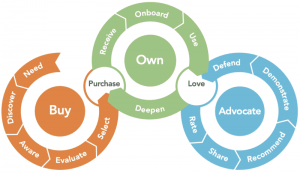Stephen Cauchi
Business reporter
Online retailing has been belted by Australia’s economic woes, with November’s sales figures recording the slowest monthly and annual growth since the series was first compiled.
And some bricks-and-mortar retailers are also doing it tough, with shares in outdoor equipment retailer Kathmandu plunging 20 per cent after poor Christmas sales forced the company to issue a profit warning.
According to National Australia Bank, not only are November’s online sales down 0.2 per cent on October, they are only 3.9 per cent higher year-on-year.
These are the slowest online growth rates recorded, according to NAB.
It is even possible that bricks-and-mortar retail may have outgrown online in November, although figures for November bricks-and-mortar retail won’t be released until January.
Overall, Australians spent $16.3 billion on online retail in the 12 months to November 2014, said NAB. This was, roughly calculated, equivalent to 6.8 per cent of spending in bricks-and-mortar retailers.
As a share of total online spend, department and variety (34 per cent), homeware (17 per cent) and groceries (15 per cent) were the three biggest categories.
Toys (39.4 per cent), media (8.7 per cent) and groceries (7.4 per cent) recorded the biggest growth rates in the year to November.
Sales from daily deals collapsed 17.5 per cent in the year to November. Personal (down 0.3 per cent) and homeware (down 3.1 per cent) also fell.
Analysts, meanwhile, are pointing to the plunging Australian dollar and questionable stocking and discounting strategies as possible reasons for Kathmandu’s woes.
Year-on-year sales, which had increased by 18.6 per cent in the year to November 15, had declined to 14.1 per cent in the year to December 21, the company said on Monday.
This was due to Christmas sales actually falling compared with last year, the company said.
“Same store sales and gross margins in the first five weeks of the company’s Christmas sales promotion in our largest market, Australia, have been below the levels achieved last year,” said a statement issued to the Australian Securities Exchange.
In contrast, “same store sales in New Zealand and the United Kingdom are currently up on the same period last year, at similar gross margins year-on-year.”
Consequently, “the company will experience a substantial reduction in the gross profit earned in the pre-Christmas Day trading period compared to the equivalent period in … 2014.”
Kathmandu’s acting chief executive, Mark Todd, said that in Australia Kathmandu’s trading performance at Christmas “has been below expectations, which is a reflection of negative consumer confidence and a difficult discretionary retail trading environment”.
Mr Todd conceded that earnings in Kathmandu’s first-half financial year – which concludes on January 31, 2015 – “will be down on the result achieved last year”.
Overall profit for the full year “remains primarily dependent on second half-year trading which in … 2014 contributed over 70 per cent of our total year’s profit,” said Mr Todd.
He was downbeat over the company’s prospects in 2015, saying that “we anticipate challenging conditions in the Australian market may continue for some time, and as a consequence, we are reassessing our sales and pricing strategy for the second half of 2015 and beyond.”
in September, Kathmandu posted a 4.5 per cent decline in annual profit to $39.29 million as earnings were hurt by a warmer start to winter – a period when it holds one of its biggest annual sales.
Retail analyst Brian Walker said the company had “developed a very strong discounting focus” and their product range was nothing special.
“Because their average sale has declined, they have to work much harder to make the sales they’re making,” he said.
“I think their range of product is much the same as it always has been. I didn’t see them bringing in any great Christmas/New Year range.
“I think it’s the same old stuff for Kathmandu in Australia, same old, same old.
“The exchange rate hasn’t helped them.”
In September, Credit Suisse produced research showing that Kathmandu was the second-most vulnerable company in Australia to a falling exchange rate. This is because the retailer imports a lot of stock.
Mr Walker said that Kathmandu was moving towards the “mass market”, away from being a hardcore adventure retailer.
This had exposed them to strong competition from players like Rebel Sport, Big W, Lorna Jane and Target, as well as their traditional competitors The North Face and Paddy Pallin.
“Kathmandu has tried to get a bit more fashion into their mix and that makes them very vulnerable to competitors,” he said. “They were very much a functional product, now they’re trying to create this look, this brand.
“They’ve gone very aggressively into the market. They’ve got a lot of sites, a lot of overhead, and they’ve got increasing competition.
“Kathmandu have positioned themselves for a mass market appeal and have entered into far more competitive waters.”
The company’s shares were down 20 per cent to $2.11 in Monday afternoon trade.
(390)
Report Post





